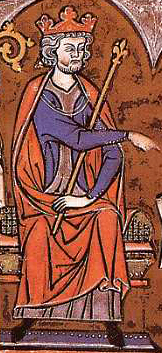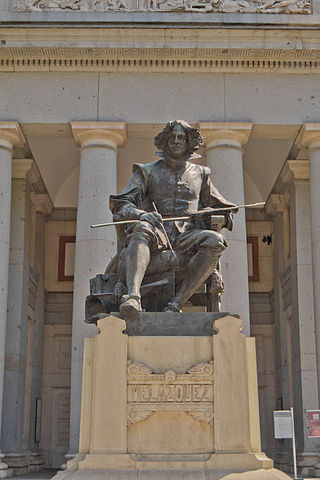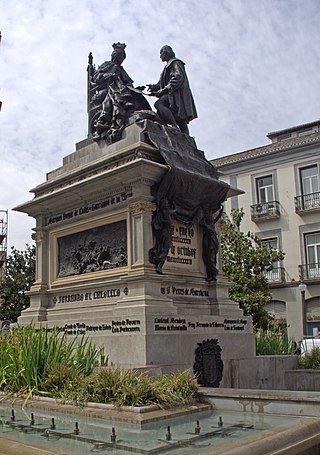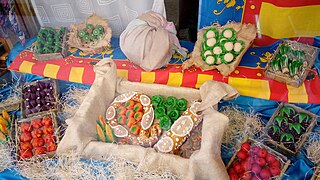
James I the Conqueror was King of Aragon, Count of Barcelona, and Lord of Montpellier from 1213 to 1276; King of Majorca from 1231 to 1276; and King of Valencia from 1238 to 1276. His long reign of 62 years is not only the longest of any Iberian monarch, but one of the longest monarchical reigns in history, ahead of Hirohito but remaining behind Queen Elizabeth II, Queen Victoria, and Ferdinand III of Naples and Sicily.

The equestrian statue of Charles IV of Spain is a bronze sculpture cast by Manuel Tolsá built between 1796 and 1803 in Mexico City, Mexico in honour of King Charles IV of Spain, then the last ruler of the New Spain. This statue has been displayed in different points of the city and is considered one of the finest achievements of Mr. Tolsá. It now resides in Plaza Manuel Tolsá.

Mariano Benlliure y Gil was a Spanish sculptor and medallist, who executed many public monuments and religious sculptures in Spain, working in a heroic realist style.
Rafael Pi Belda was a Spanish sculptor. He studied beaux-arts in Valencia under the guidance of Enrique Pérez Comendador and José Ortells López. His works are mainly figurative.

The Battle of the Puig of 1237, also known as the Battle of the Puig de Santa Maria, the Battle of the Puig de Enesa, or the Battle of the Puig de Cepolla was a battle of the Iberian Reconquista and of the Aragonese Conquest of Valencia.

Public art in Barcelona is a designated group of monuments and outdoor sculptures in the city. The artworks in city's architecture and network of museums, parks, and gardens, put an artistic stamp on the Catalan capital. Public art in the city developed in the 19th century, although the first municipal commission was the 1673 monument to Saint Eulalia in Pedró Square.
Miquel Navarro is a Spanish sculptor, painter and contemporary poet.

9 d'Octubre is a historical celebration in the Land of Valencia, the official day of the Valencian Community since its recogntion as an Autonomus Community of Spain. It commemorates the conquest of the city of Balansiya by the troops of James I of Aragon and the creation of the Kingdom of Valencia in 1238.

Agapit Vallmitjana i Barbany was a Spanish sculptor, in the Realist style. His brother Venanci was also a sculptor, with whom he usually collaborated.

The Monument to Isabella the Catholic is an instance of public art located in Madrid, Spain. A work by Manuel Oms, the monument is a sculptural bronze ensemble consisting of an equestrian statue of Isabella of Castile, accompanied by Pedro González de Mendoza and Gonzalo Fernández de Córdoba.

The Monument to Cánovas del Castillo is an instance of public art located in Madrid, Spain. The monument consists of a bronze statue of Antonio Cánovas del Castillo by Joaquín Bilbao at the top of a pedestal designed by José Grases Riera that features additional sculptural elements by Bilbao.

Espartero, or the monument to General Espartero, is an instance of public art in Madrid, Spain. A work by Pablo Gibert, it is dedicated to General Baldomero Espartero, "the Peacemaker".

Marqués del Duero, also known as Monumento al Marqués del Duero, is an instance of public art located in Madrid, Spain. Erected on the centre of the Plaza del Doctor Marañón, the monument consists of a bronze equestrian statue representing Manuel Gutiérrez de la Concha e Irigoyen—a general who stood out in the fight against Carlism—on a stone pedestal decorated with two reliefs.

Velázquez or the Statue of Velázquez is an instance of public art in Madrid, Spain. Located in front of the main gate of the Prado Museum, it is dedicated to Diego de Velázquez.

A los héroes del dos de mayo or Al pueblo del dos de mayo de 1808 is an instance of public art in Madrid, Spain. A sculptural work by Aniceto Marinas, the monument is an homage to the role of the Madrilenian people during the 1808 Dos de mayo uprising.

The monument to Primo de Rivera is an instance of public art in Jerez de la Frontera, Spain. It consists of a bronze equestrian statue of Miguel Primo de Rivera, on top of a sculptural ensemble placed inside a fountain. It lies at the centre of the Plaza del Arenal.

The Monument to Claudio Moyano is an instance of public art in Madrid, Spain. Designed by Agustín Querol and located at the Plaza del Emperador Carlos V, it consists of a bronze statue of Claudio Moyano, a 19th century statesman noted for the authorship of the 1857 Law of Education, put on top of a tall stone pedestal.

Agustina Zaragoza y las Heroínas or the Monument to Agustina de Aragón is an instance of public art in Zaragoza, Spain. Designed by Mariano Benlliure, it consists of a bronze statue of Agustina de Aragón topping off a stone pedestal that displays two other sculptural groups and a number of reliefs. The latter subsidiarily pay homage to another six heroines of the Zaragozan theatre of the Peninsular War.

The Monument to Isabella the Catholic also known as the Monumento a Isabel la Católica y Colón or monumento del IV Centenario is an instance of public art in Granada, Spain. Designed by Mariano Benlliure, it consists of a bronze sculptural group depicting a meeting of Isabella I of Castile with Christopher Columbus.

Mocadorada, is a tradition from the Valencian Community celebrated each October 9, concurring with the National Day of Valencia. It consists of a collection of frutta martorana where the marzipan fruits are held inside of a handkerchief.





















